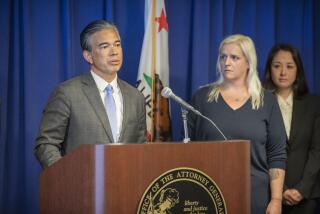Brittany Maynard dead; right to die widely supported, and widely illegal
- Share via
You can’t really choose when to begin your life, but at the other end of the scale, the battle over the choice to legally end life has become more complex after Brittany Maynard, a right-to-die advocate, took the ultimate step.
Maynard, who had brain cancer, chose to end her life on Saturday as she promised she would about a month ago when she and her husband moved from Northern California to Portland, Ore., where the right to die is legal. Washington, Montana, Vermont and New Mexico are the only other states that allow terminal patients to seek medical help to die.
“She died as she intended — peacefully in her bedroom, in the arms of her loved ones,” according to the advocacy group Compassion & Choices, with which Maynard was working. She would have been 30 years old on Nov. 19.
Because she was young and vibrant -- and publicly announced her decision in a series of television interviews and social media postings -- Maynard was not the usual face in the right-to-die debate.
Polls show that seven out of 10 Americans say they support physician-assisted suicide if the patient wants to end his or her life painlessly. A majority of Americans first said they supported that position almost 40 years ago. The strong majority of about seven out of 10 has been constant for the last two decades.
Yet, despite those numbers, just five states legally back the right to die. Legislative efforts in several states, including California, have failed.
Proponents argue that an adult should be allowed to legally choose to end his life, painlessly and surrounded by loved ones, instead of having to drag out the inevitable -- much to a patient’s harm. What can be the value of needless suffering at the end of life?
Opponents cite religious arguments that all life, regardless of its quality, is sacred and should be preserved. There are also questions about the circumstances: Are relatives seeking to relieve themselves of an unwanted, and often expensive, burden while insurance companies and even municipalities in some cases want to save dollars? And what of the occasional miracle when someone who is deemed beyond hope does recover?
Until Maynard, much of the debate about a right to die revolved around euthanasia proponent Jack Kevorkian, who embodied both sides of the argument in the 1980s. A pathologist, Kevorkian claimed to have helped 130 people die.
But later studies, including one by the Detroit Free Press, raised questions.
About 60% of those who died with Kevorkian’s help were not terminally ill and 13 of them didn’t have pain, according to the newspaper. In one case, the dead woman’s husband made the arrangements and Kevorkian met her just two days before the assisted suicide. Backers insisted that Kevorkian was a hero taking all proper care and was being pursued for his beliefs.
In November 1998, Kevorkian allowed television to broadcast the voluntary euthanasia of a 52-year-old man said to be in the final stages of Lou Gehrig’s disease. The tape showed Kevorkian administering the final injection himself, a departure from earlier practice when the patient completed the killing shot.
The death was designed to raise the stakes in the battle over euthanasia -- and it did.
In 1999, Kevorkian was charged with second-degree murder and the delivery of a controlled substance. He was eventually convicted of second-degree homicide and sentenced to 10 to 25 years in prison. He served more than eight years before he was released.
There is a fine line between helping someone with a terminal condition to die and allowing anyone to kill himself. Kevorkian in 2010 blurred that distinction when he said in a CNN interview that he supported all euthanasia: “What difference does it make if someone is terminal? We are all terminal.”
Maynard’s case in Oregon was different in that state law restricts the choice to the terminally ill.
Some religious groups and others opposed to physician-assisted suicide said they still objected.
“Brittany’s death was not a victory for a political cause. It was a tragedy, hastened by despair and aided by the culture of death invading our country,” Janet Morana, executive director of the group Priests for Life, said in a statement after Maynard’s death.
Oregon was the first U.S. state to make it legal for a doctor to prescribe a life-ending drug to a terminally ill patient of sound mind who asked for it. The patient must take the drug without help.
Before dying, Maynard and her husband fulfilled her last wishes, including a trip to the Grand Canyon.
Maynard told the Associated Press in an Oct. 8 interview that her husband and other relatives accepted her decision to die.
“I think in the beginning my family members wanted a miracle; they wanted a cure for my cancer,” she said. “When we all sat down and looked at the facts, there isn’t a single person that loves me that wishes me more pain and more suffering.”
Follow @latimesmuskal for national news.
More to Read
Sign up for Essential California
The most important California stories and recommendations in your inbox every morning.
You may occasionally receive promotional content from the Los Angeles Times.











